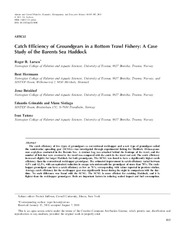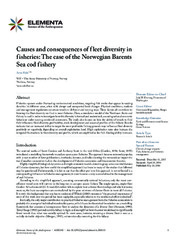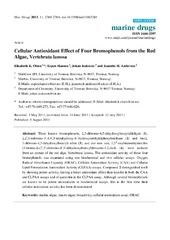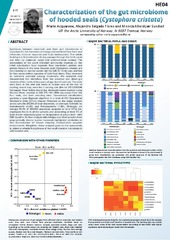Blar i tittel Artikler, rapporter og annet (Norges fiskerihøgskole)
Viser treff 118-137 av 930
-
Catch Efficiency of Groundgears in a Bottom Trawl Fishery: A Case Study of the Barents Sea Haddock
(Journal article; Tidsskriftartikkel; Peer reviewed, 2018-10-10)The catch efficiency of two types of groundgear—a conventional rockhopper and a new type of groundgear called the semicircular spreading gear (SCSG)—was investigated through experimental fishing for Haddock Melanogrammus aeglefinus conducted in the Barents Sea. A retainer bag was attached behind the footrope of the trawl, and the number of fish that were overrun by the trawl was compared with the ... -
Catch pattern and size selectivity for a gear designed to prevent fish injuries during the capture process in a North-East Atlantic demersal trawl fishery
(Journal article; Tidsskriftartikkel; Peer reviewed, 2020-11-04)In the North-East Atlantic demersal trawl fishery targeting cod and haddock, the interest on fishing gear designs that preserve fish quality and welfare has grown. However, the gear configurations tested so far imply practical challenges, therefore, more user-friendly designs are still sought by the industry. For a new design to be considered, it needs to have size selective properties that are at ... -
Catch-based aquaculture in Norway - Institutional challenges in the development of a new marine industry
(Journal article; Tidsskriftartikkel; Peer reviewed, 2019-03-12)Catch-based aquaculture (CBA) is an important production system in many parts of the world, especially in developing countries. In Norway CBA is based on capture and storage/farming of mature, North-east Atlantic (NEA) cod (Gadus morhua). The objective is to reduce seasonal variations and add value, by storing/farming fish to take advantage of higher prices in low seasons. Despite numerous development ... -
Causes and consequences of fleet diversity in fisheries: The case of the Norwegian Barents Sea cod fishery
(Journal article; Tidsskriftartikkel; Peer reviewed, 2016-05-25)Fisheries operate under fluctuating environmental conditions, targeting fish stocks that appear in varying densities in different areas, often with abrupt and unexpected local changes. Physical conditions, markets and management regulations constrain vessels in different and varying ways. These factors all contribute to forming the fleet diversity we find in most fisheries. Here, a simulation model ... -
Cellular Antioxidant Effect of Four Bromophenols from the Red Algae, Vertebrata lanosa
(Journal article; Tidsskriftartikkel; Peer reviewed, 2013)Three known bromophenols, 2,3-dibromo-4,5-dihydroxybenzylaldehyde (1), 2,2′,3-tribromo-3′,4,4′,5-tetrahydroxy 6′-hydroxymethyldiphenylmethane (2) and bis(2, 3-dibromo-4,5-dihydroxylbenzyl) ether (3), and one new one, 5,5″-oxybis(methylene)bis (3-bromo-4-(2′,3′-dibromo-4′,5′-dihydroxylbenzyl)benzene-1,2-diol) (4), were isolated from an extract of the red alga, Vertebrata lanosa. The antioxidant ... -
Certify or not? The effect of the MSC certification on the ex-vessel prices for Atlantic cod in Norway
(Journal article; Tidsskriftartikkel; Peer reviewed, 2023-07-19)There is strong evidence that ecolabeled seafood commands a price premium in the retail market in Northern European countries. At the same time, there is significant uncertainty as to whether these markups are passed on to the fishers. This is important because producer benefits are required for an ecolabel to provide incentives for sustainable fishery management and fishing practices. Therefore, ... -
Change in Fish Community Structure in the Barents Sea
(Journal article; Tidsskriftartikkel; Peer reviewed, 2013)Change in oceanographic conditions causes structural alterations in marine fish communities, but this effect may go undetected as most monitoring programs until recently mainly have focused on oceanography and commercial species rather than on whole ecosystems. In this paper, the objective is to describe the spatial and temporal changes in the Barents Sea fish community in the period 1992–2004 while ... -
Changes in softbottom macrofauna communities along environmental gradients
(Journal article; Tidsskriftartikkel; Peer reviewed, 1990-12-21) -
Changing fish distributions challenge the effective management of European fisheries.
(Journal article; Tidsskriftartikkel; Peer reviewed, 2020-01-23)Changes in fish distribution are being observed across the globe. In Europe's Common Fisheries Policy, the share of the catch of each fish stock is split among management areas using a fixed allocation key known as ‘Relative Stability’: in each management area, member states get the same proportion of the total catch each year. That proportion is largely based on catches made by those member states ... -
Characterization of myeloperoxidase and its contribution to antimicrobial effect on extracellular traps in flounder (Paralichthys olivaceus)
(Journal article; Tidsskriftartikkel; Peer reviewed, 2023-01-26)Myeloperoxidase (MPO) is a cationic leukocyte haloperoxidase and together with other proteins, they possess activities against various microorganisms and are involved in extracellular trap (ET) formation. The present work describes the gene and deduced protein sequences, and functions of MPO in flounder (PoMPO). The PoMPO possesses a 2313 bp open reading frame (ORF) that encodes a protein of 770 ... -
Characterization of Rhamnolipids Produced by an Arctic Marine Bacterium from the Pseudomonas fluorescence Group
(Journal article; Tidsskriftartikkel; Peer reviewed, 2018-05-14)The marine environment is a rich source of biodiversity, including microorganisms that have proven to be prolific producers of bioactive secondary metabolites. Arctic seas are less explored than warmer, more accessible areas, providing a promising starting point to search for novel bioactive compounds. In the present work, an Arctic marine Pseudomonas sp. belonging to the Pseudomonas (P.) fluorescence ... -
Characterization of the gut microbiome of hooded seals (Cystophora cristata)
(Conference object; Konferansebidrag, 2016-03-14) -
Chlovalicin B, a Chlorinated Sesquiterpene Isolated from the Marine Mushroom Digitatispora marina
(Journal article; Tidsskriftartikkel; Peer reviewed, 2021-12-13)As part of our search for bioactive metabolites from understudied marine microorganisms, the new chlorinated metabolite chlovalicin B (1) was isolated from liquid cultures of the marine basidiomycete Digitatispora marina, which was collected and isolated from driftwood found at Vannøya, Norway. The structure of the novel compound was elucidated by spectroscopic methods including 1D and 2D NMR and ... -
Choice of climate risk adaptive measures in shrimp farming—A case study from the Mekong, Vietnam
(Journal article; Tidsskriftartikkel; Peer reviewed, 2023-11-06)Extreme climate events challenge the livelihoods of shrimp farmers worldwide. A comprehensive analysis of farmers’ choices of adaptive measures is essential for developing approaches that can lessen the effects of these climate risks. This study presents the determinants that influence the choice of adaptive measures in response to two climate risks, drought, and irregular weather, using a survey ... -
Citizens in the Lab: Performance and Validation of eDNA Results
(Journal article; Tidsskriftartikkel; Peer reviewed, 2021-12-16)Citizen Science has traditionally been applied in biodiversity monitoring, as the approach holds the potential for conducting large-scale data collections. However, involving citizens in more than data collection is still in its infancy. In this paper, we present the results of an ongoing citizen science project that expands the partnership between citizens and researchers by involving citizens in ... -
Cleaner fish in aquaculture: review on diseases and vaccination
(Journal article; Tidsskriftartikkel; Peer reviewed, 2020-07-26)Combating and controlling sea lice causes large economic costs for the farmers, with estimated values of more than 305 million euros (€) per year. Increased resistance against traditional chemotherapeutants due to evolutionary drivers in the sea lice combined with the lack of an effective vaccine and few other chemical treatments available are expected to cause these costs to increase. Several ... -
Climate change alters the structure of arctic marine food webs due to poleward shifts of boreal generalists
(Journal article; Tidsskriftartikkel; Peer reviewed, 2015-09-02)Climate-driven poleward shifts, leading to changes in species composition and relative abundances, have been recently documented in the Arctic. Among the fastest moving species are boreal generalist fish which are expected to affect arctic marine food web structure and ecosystem functioning substantially. Here, we address structural changes at the food web level induced by poleward shifts via ... -
Climate change, fisheries management and fishing aptitude affecting spatial and temporal distributions of the Barents Sea cod fishery
(Journal article; Tidsskriftartikkel; Peer reviewed, 2017-10-26)Climate change is expected to influence spatial and temporal distributions of fish stocks. The aim of this paper is to compare climate change impact on a fishery with other factors impacting the performance of fishing fleets. The fishery in question is the Northeast Arctic cod fishery, a well-documented fishery where data on spatial and temporal distributions are available. A cellular automata ... -
Climate Mitigation through Biological Conservation: Extensive and Valuable Blue Carbon Natural Capital in Tristan da Cunha’s Giant Marine Protected Zone
(Journal article; Tidsskriftartikkel; Peer reviewed, 2021-12-16)Carbon-rich habitats can provide powerful climate mitigation if meaningful protection is put in place. We attempted to quantify this around the Tristan da Cunha archipelago Marine Protected Area. Its shallows (<1000 m depth) are varied and productive. The 5.4 km<sup>2 </sup>of kelp stores ~60 tonnes of carbon (tC) and may export ~240 tC into surrounding depths. In deep-waters we analysed seabed data ... -
Climate Performance, Environmental Toxins and Nutrient Density of the Underutilized Norwegian Orange-Footed Sea Cucumber (Cucumaria frondosa)
(Journal article; Tidsskriftartikkel; Peer reviewed, 2022-12-26)Low trophic species are often mentioned as additional food sources to achieve broader and more sustainable utilisation of the ocean. The aim of this study was to map the food potential of Norwegian orange-footed sea cucumber (Cucumaria frondosa). C. frondosa contained 7% protein, 1% lipids with a high proportion of polyunsaturated fatty acids, and a variety of micronutrients. The nutrient density ...


 English
English norsk
norsk


















